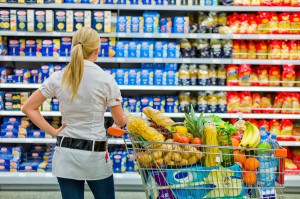This summer, the cost of pretty much everything has gone up: meat, eggs, fruit, vegetables, water and gas. Due to this, consumers have been cautious as to what they are consuming in the hot summer months of July and August. In fact, they are using various methods to cut back on expenses and save more money.
According to a new Gallup poll, shoppers have decided to combine the buying and saving techniques that are both conventional and unconventional. For instance, 83 percent of consumers purchased a generic or store brand for their household needs, while 61 percent visited more than one store to get the best deal possible.
It’s traits like these that are possibly helping households tighten their budgets and stretch every penny to ensure that they don’t live paycheck to paycheck and have more money in their accounts for rainy days.
 Gallup’s research also discovered that 59 percent of Americans are heading online to search for the best deal, 58 percent of consumers used coupons when going shopping, 55 percent followed a strict budget and 40 percent acquired used goods.
Gallup’s research also discovered that 59 percent of Americans are heading online to search for the best deal, 58 percent of consumers used coupons when going shopping, 55 percent followed a strict budget and 40 percent acquired used goods.
Furthermore, consumers are scaling back on their consumption habits. Case in point, 61 percent of survey participants did not make an impulse purchase in the past four weeks, 69 percent have refused to go shopping for fun and nearly three-quarters (73 percent) of consumers have not made a major purchase that cost at least one week’s pay.
Another interesting finding from the study to note is that Americans’ attitude towards saving is changing. For example, a growing number of consumers are becoming more careful of how they spend their money (75 percent agree), saving some of the money they receive (62 percent agree), and shopping only for what they need (52 percent agree).
Meanwhile, convenience and spending money right away are the last things on Americans’ minds.
“Discounting has become so ubiquitous that it is possible that consumers will avoid retailers who do not discount. While Americans are spending more on household essentials, they have less available to spend on discretionary items, such as leisure activities, travel, dining out, and consumer electronics,” Gallup said in its statement.
“Even more to the point, American consumers are foregoing major purchases and rarely shopping for fun. It is likely that a more robust economy will see the return of the joy of shopping, but, paradoxically, the joy of shopping for fun, making major purchases, and spending on discretionary items is what fuels economic growth.”
Does consumption incite economic growth, as many Keynesians argue? Not if you ask certain economists who aver the case that saving and investing are what fuel the economy and that debt-driven consumption doesn’t create genuine long-term growth.
Here is what economist Jonathan M. Finegold Catalan wrote in 2010:
“Savings, or capital accumulation, is the most important direct factor in wealth creation. The volume of capital directly influences the cost to borrow said capital, otherwise known as the rate of interest. Naturally, the greater the supply of capital, the lower the cost to borrow, providing an incentive for entrepreneurs to borrow and invest.”
The Gallup telephone survey was conducted with 1,029 adults between Jun. 9 and 15. It contains a margin of error of +/- four percentage points.



